Configuring Radial Gauge
Radial Gauge allows you to measure processing efficiency through key performance indicators (KPIs) such as value and goal.
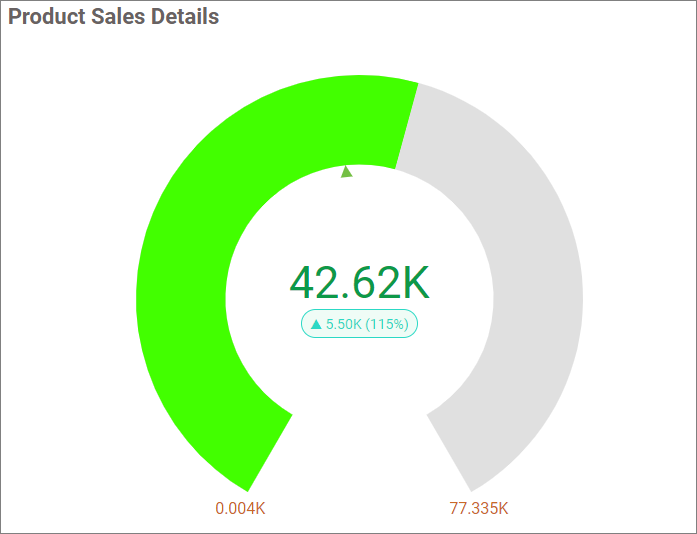
How to configure data to Radial Gauge
Radial Gauge requires at least one actual value and/or one target value to display.
Follow these steps to configure data for the Radial Gauge:
- Drag the Radial Gauge onto the canvas and adjust its size as needed.
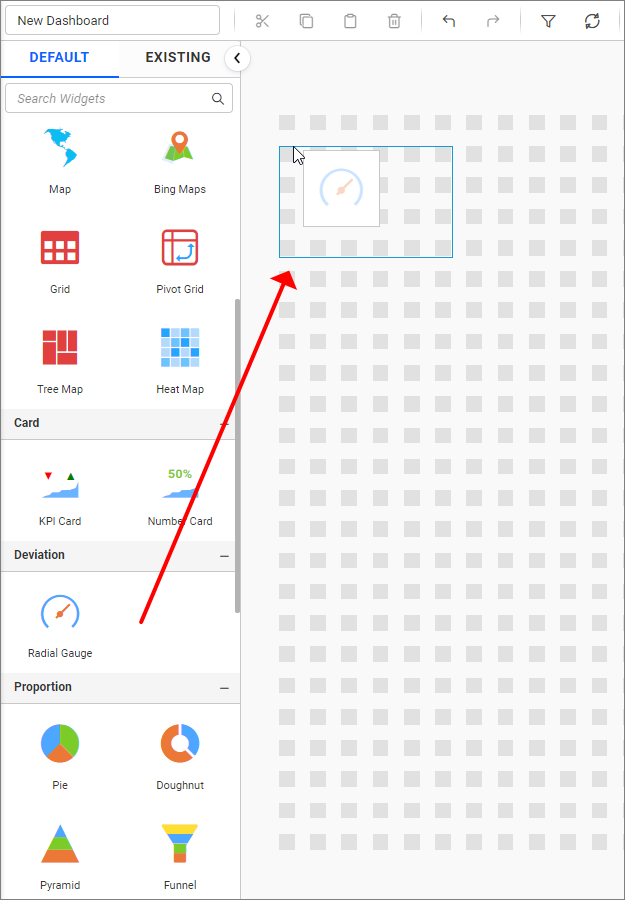
- Click on the
Data Sourcebutton in the configuration panel.
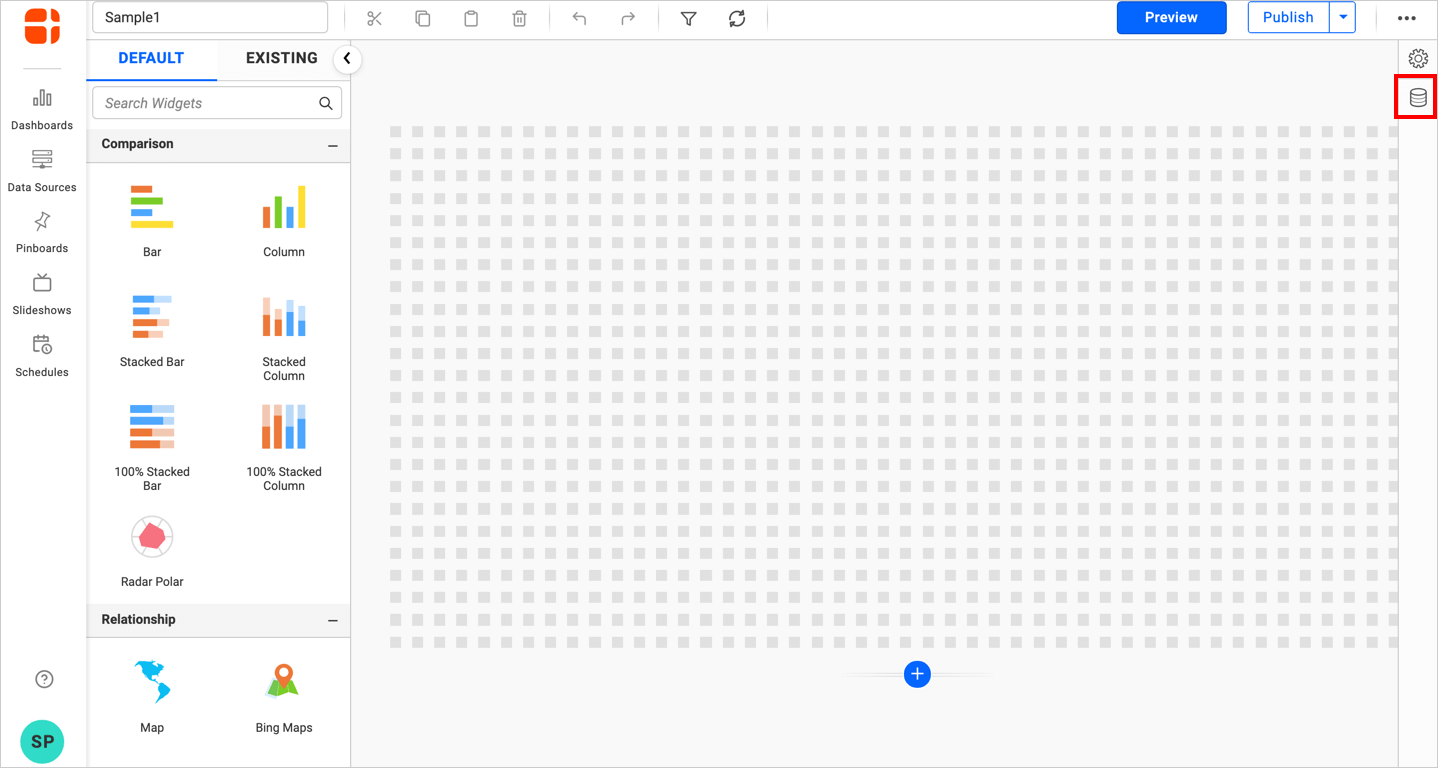
- Click on
CREATE NEWto establish a new connection from the connection type panel.

- In the
DATA SOURCESpanel, select one of the listed connection type buttons. For this demonstration, theMicrosoft Exceltype is chosen.

- In the
NEW DATA SOURCEconfiguration panel, enter the name, choose the file path, and then clickPreview & Connect.
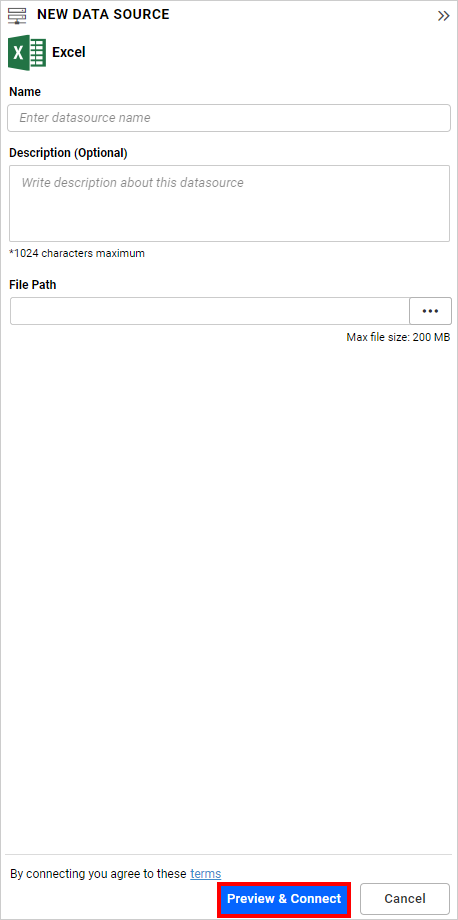
- Select the required tables from the
Choose Table(s)dialog and clickConnect.
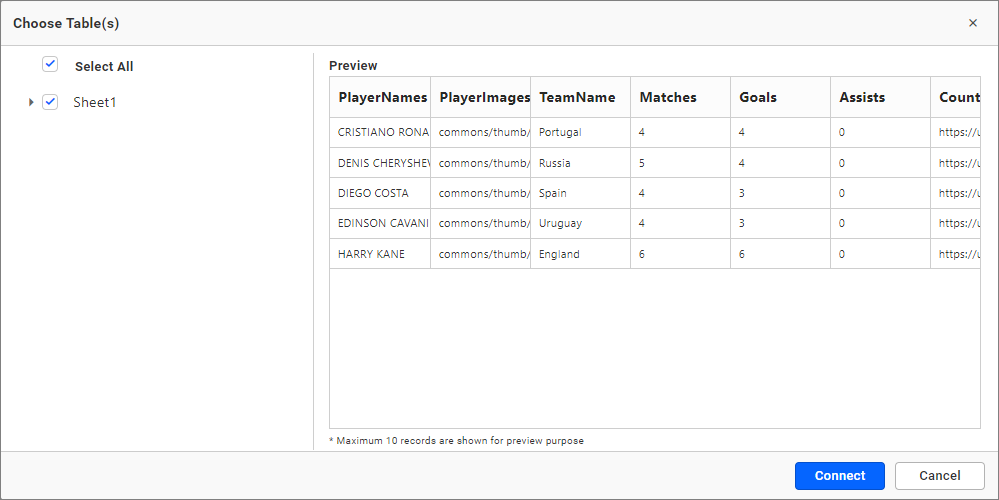
- Drag your preferred table or view from the left pane in the data design view and click
Save.

- Click the
Propertiesbutton in the configuration panel. The property pane opens.
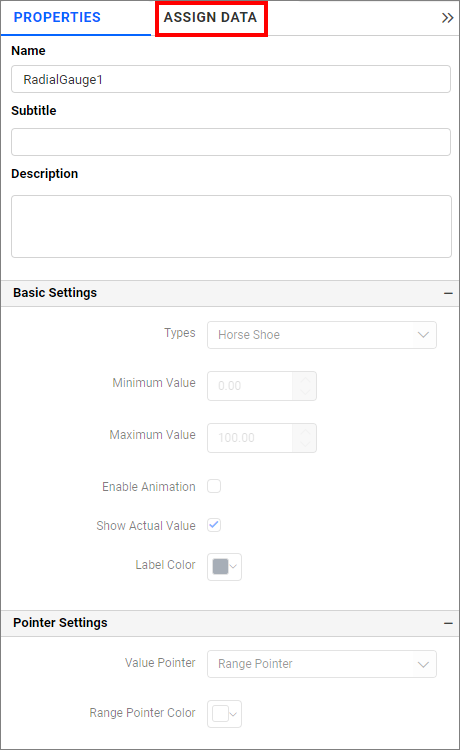
- Now, switch to the
ASSIGN DATAtab.

- The data tab will be opened with available
MeasuresandDimensionsfrom the connected data source.
Actual Value
Bind the column by dragging any field from any section to the Actual Value.
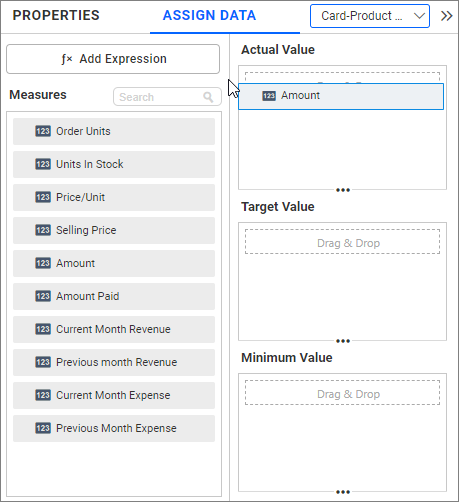
Aggregate Function
You can use the aggregate function to change the actual values of the Radial Gauge.

Renaming fields
The configured field names can be edited by using the Rename option provided in the settings menu.

Filtering data
You can use the Filter option to filter the data by specifying the filter condition. For more details, refer to the filter.
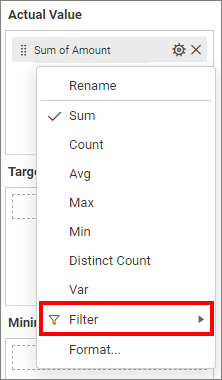
Formatting data
You can format the data to be displayed in the gauge by using the Format option.
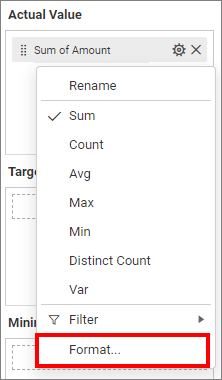
NOTE: Refer to the measure format for more details on Measure formatting.
Target Value
Similarly, drag any field from any section to Target Value.
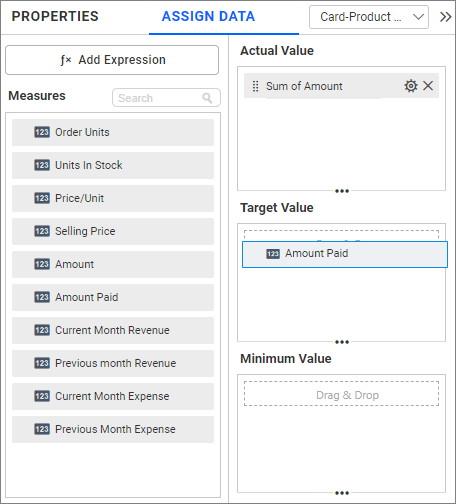
Series
Drag any field from the Dimensions section to Series.
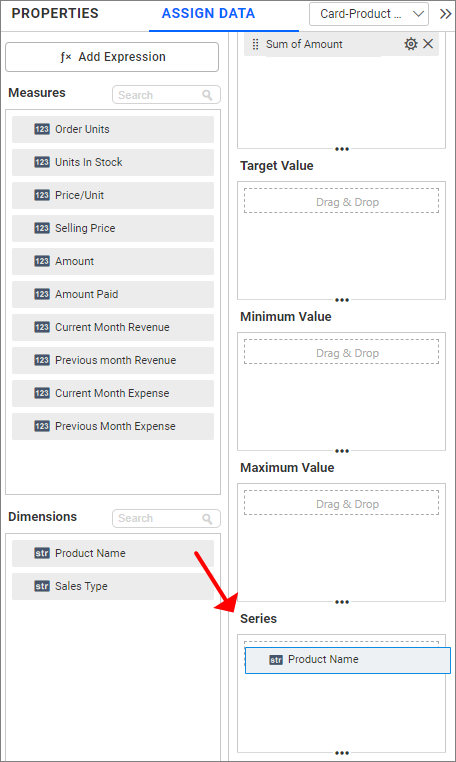

Settings
You can apply the Sort and Filter options for the Series field if required from the settings menu.
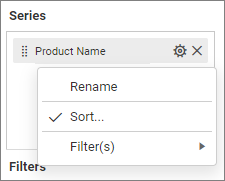
Sorting: You can customize the sorting behavior of dimension fields in the Radial Gauge widget. You can order them based on alphabet or value, data source (default), or field. Refer to the Sort for detailed steps.
Filtering: You can use the Filter option to filter the data by specifying the filter condition. Refer to the detailed steps on applying measure filter from this page.
Minimum Value
Drag any field from the Measures section to Minimum Value. If the minimum value is configured, then this value will be the start range for the gauge widget.
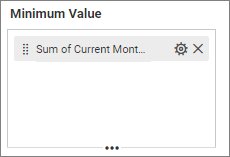
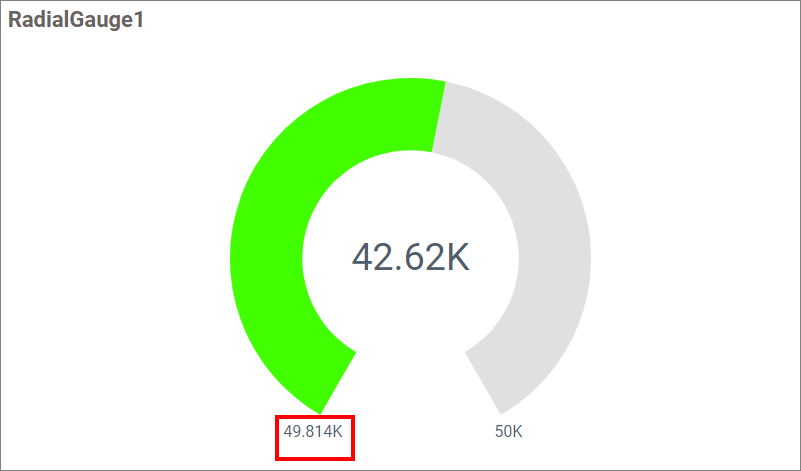
Maximum Value
Drag any field from the Measures section to the Maximum Value. If the maximum value is configured, it will act as the end range for the gauge widget.
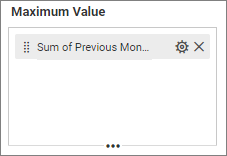
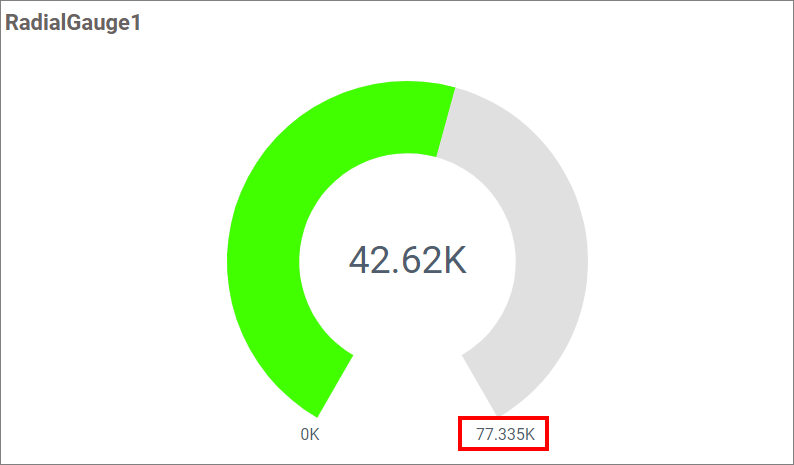
Hidden Column
Hidden columns are useful in cases where we don’t want the fields to take part in the visualization, but only to be used for linking, filtering and view data.
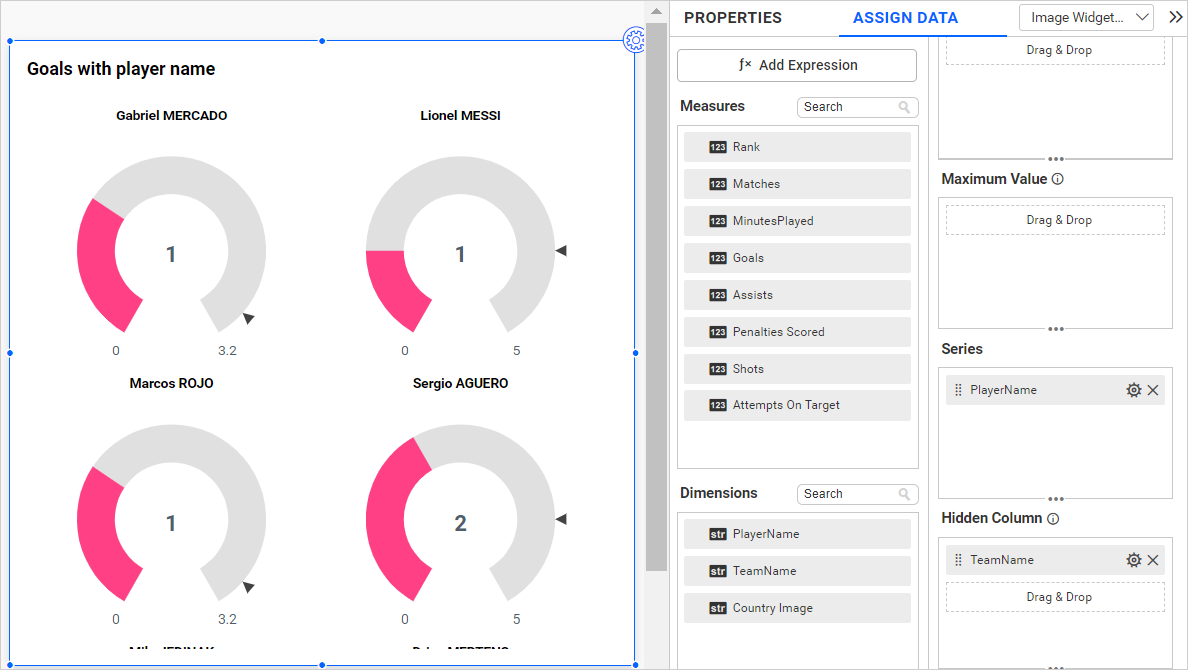
In the case of dimension fields, we will have the following options only. In Date fields, we will have all available types except sorting, relative date filter, settings, and filters.



Linking
The primary use case of hidden columns is linking. When configuring hidden columns, the fields configured are listed in the linking section. By configuring the column in linking, we can pass the corresponding column value in the linking parameter.
Measure Based Example: If we wish to pass the number of Matches played as a URL parameter but do not want it to influence the visualization, we can configure Matches in the hidden columns and incorporate them into the link.
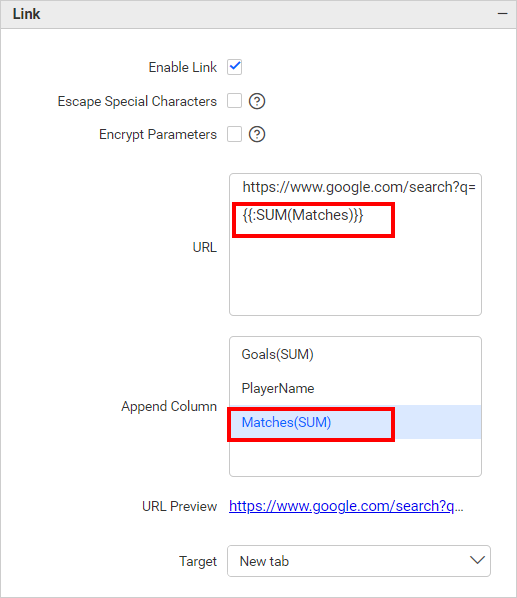
Dimension Based Example: If we wish to pass the Team Name as a URL parameter but do not want it to influence the visualization, we can configure the Team Name in the hidden columns and incorporate it into the link.

Filtering
Hidden columns can be used to filter data in the visualizations. Configure hidden columns and click on the filter icon.
![]()
Click the Custom button highlighted in the filter configuration dialog image to list all the fields configured in the widget. Keep the field configured in the hidden column and remove the other fields, then click the Update button.

Now, in the image below, the data is filtered based on the hidden column field instead of the actual column bound in the widget.
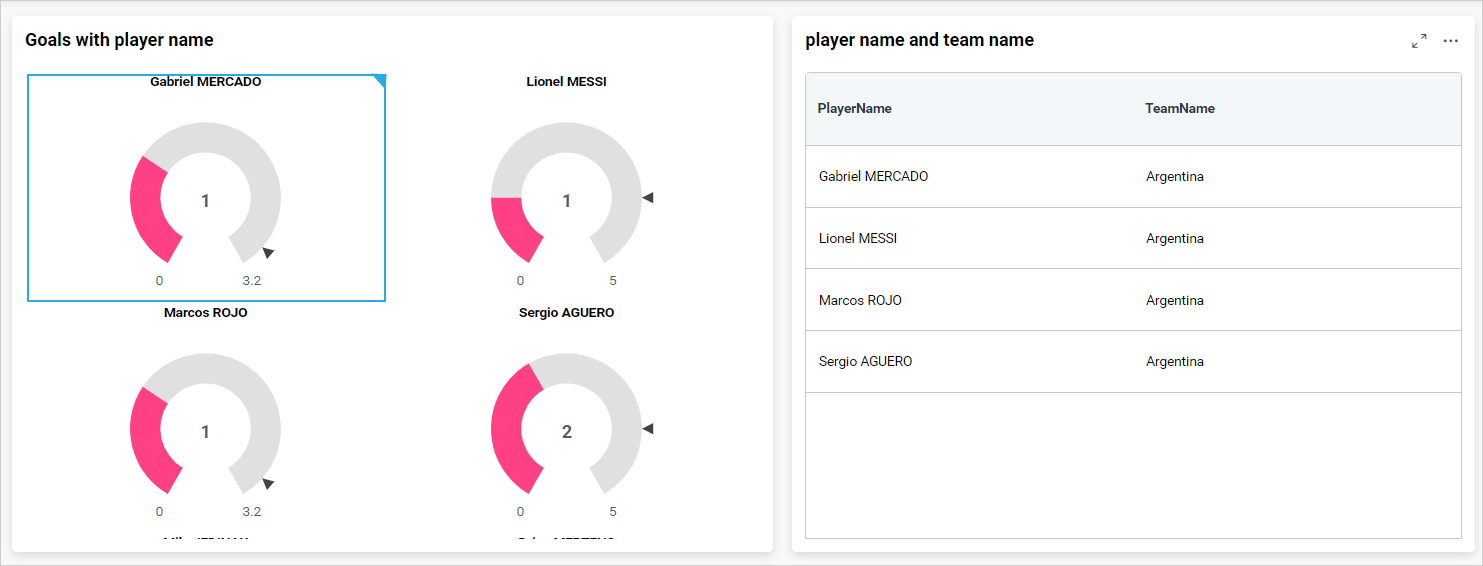
To learn more about filtering the widget data, refer to the Cross Filter Configuration documentation.
View Data
You can view the data in the hidden columns in the underlying data view. This is useful for checking the data in more detail and can help you identify any issues with the data.
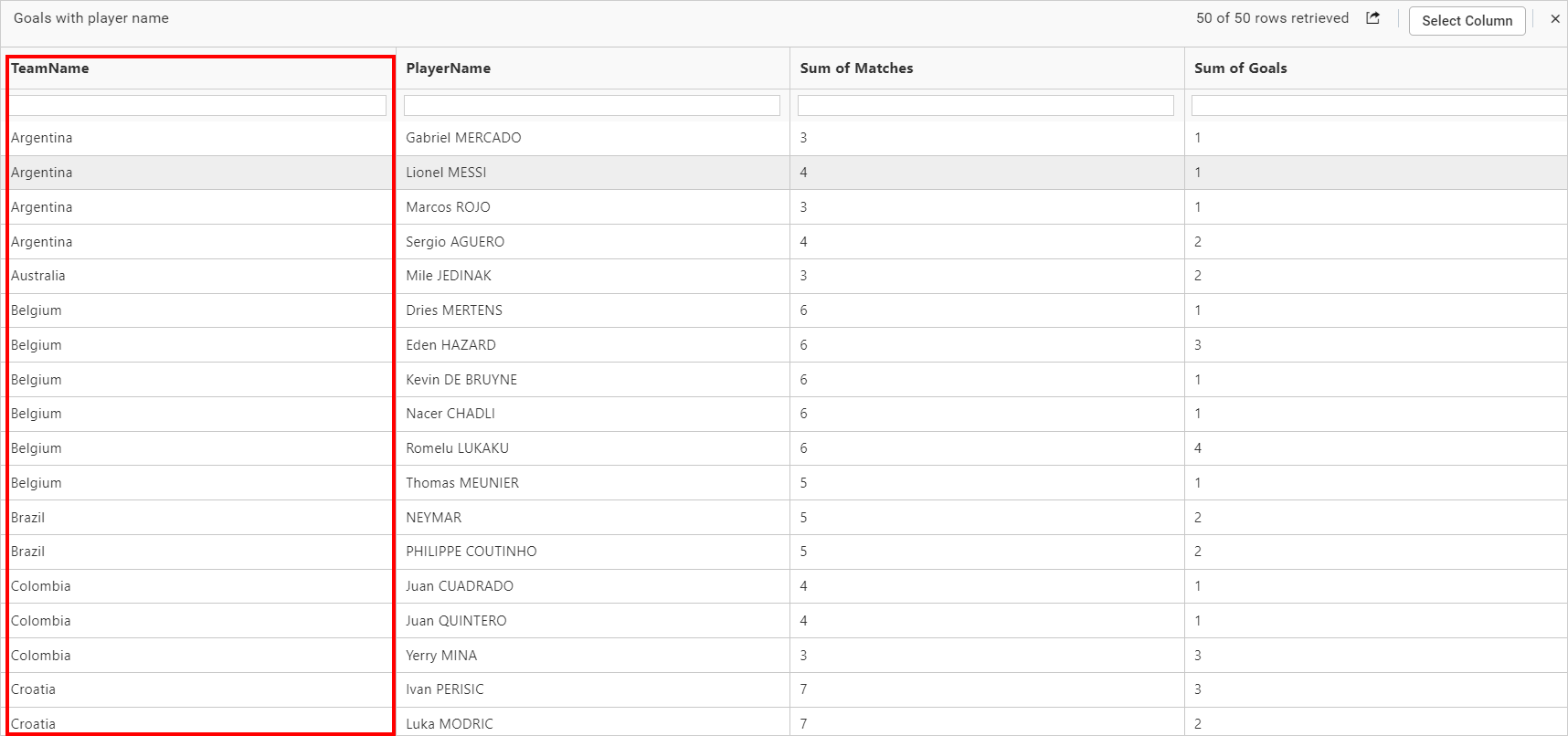
NOTE: We do not recommend configuring lower hierarchy data in hidden columns, as indicated by the info icon in the
Hidden Columnsection.
![]()
The gauge below displays the goals and attempts on target by each team without any hidden columns.

If we configure lower hierarchy data (Player Name) in hidden columns, incorrect data will be displayed on the gauge.

How to format the Radial Gauge
You can format the Radial Gauge for better illustration of the view through the settings available in the Properties tab.
To format the Radial Gauge, follow these steps:
-
Drag the Radial Gauge onto the canvas and resize it to your required size.
-
Configure the data into the Radial Gauge.
-
Focus on the Radial Gauge and click the
settingsicon.
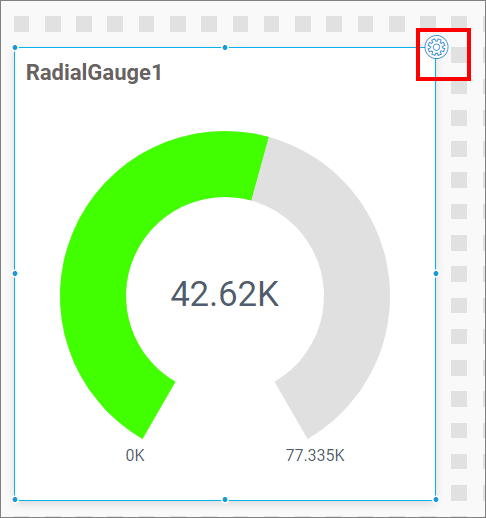
General Settings

Name
This option allows you to change the title for the Radial Gauge.

Subtitle
Allows you to provide a subtitle for the Radial Gauge.
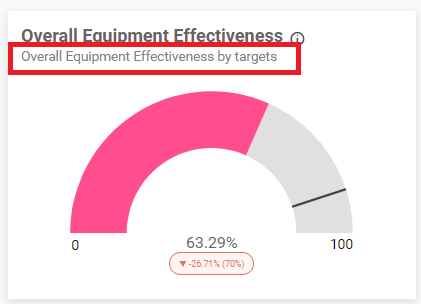
Description
Allows you to provide a description about the Radial Gauge.
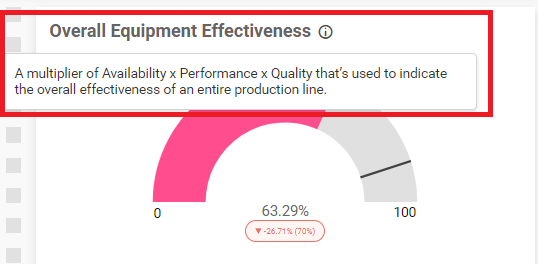
Basic Settings
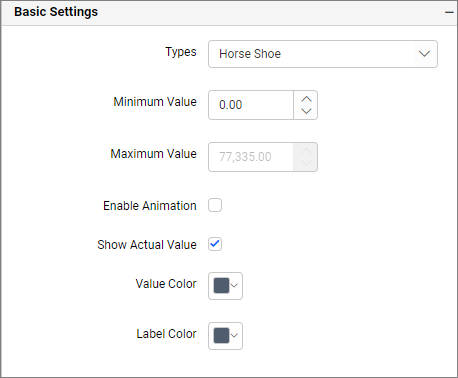
Show Tooltip
This option allows you to toggle the visibility of tooltip in the radial gauge.

Gauge Type
Allows you to switch the widget view from the Half Circle type to Horse Shoe type or Full circular gauge, or vice versa. The default type is Horse Shoe.
Note: If you change the gauge type to
Full circle, the Color settings or Range settings categories will be hidden. In the Pointer settings category, the Value Pointer, Target Pointer, and Target Color properties will be hidden, and in theScale settingscategory, Show ticks, Show label, and their dependent properties will be hidden. TheSizeoption will be shown, which is used to customize the font size of the difference value.
Half Circular Gauge
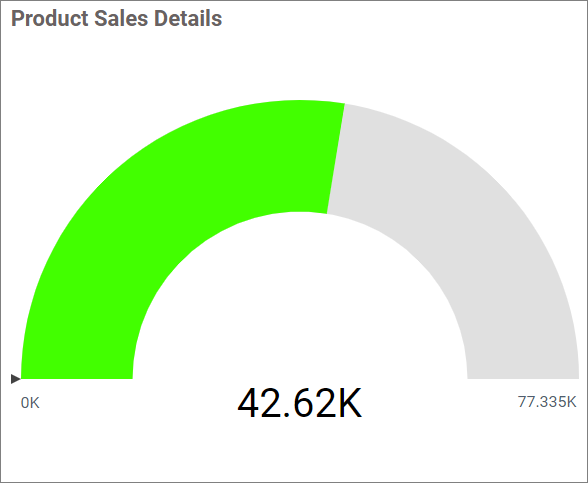
Full circular Gauge
You can change the type to Full Circle to display a full circular gauge. If changed, the gauge will render like this. For the full circular type, the difference value will not be shown; only the percentage of the difference value will be displayed.

For the full circular gauge, some categories in the property panel will be hidden. If properties are applied before changing their type, which is unnecessary for the full circular gauge, they will be reverted. Here is a list of categories that do not support the full circular gauge:
- Color Settings
- Range Settings
In the property panel, two additional properties (Difference value color and size) are shown in the Basic Settings for the full circular gauge:
Difference value color
You can apply color for difference value of the gauge.
Difference value size
Change the size of the difference value. The default value is 15, and it can be changed between 12 and 55.
Minimum Value
Change the minimum value of the gauge. This option will be disabled when configuring the column to start value in the data configuration panel.
Maximum Value
Change the maximum value of the gauge. This option will be disabled when configuring the column to end value in the data configuration panel.
Enable Animation
Enable the animation for the gauge by setting this property to true. The default value is false.
Show Actual value
Hide or show the actual value in the gauge by disabling or enabling the option. The default value is true.
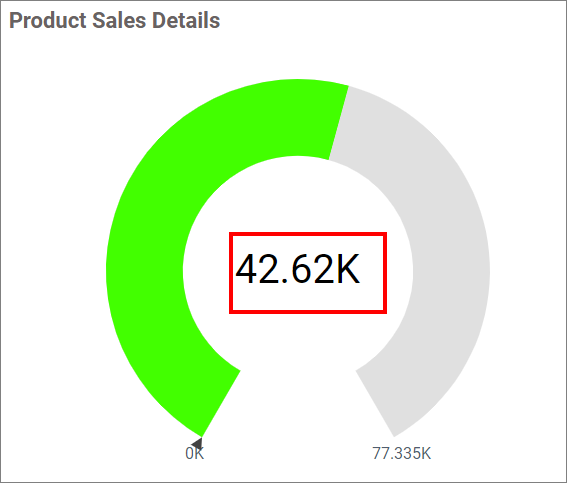
Value Color
Apply a color for the actual value displayed in the Radial Gauge. The default value is #666666.

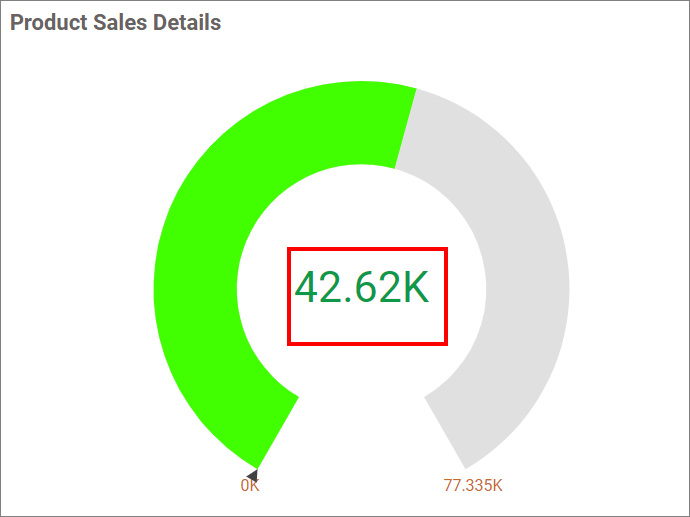
If you uncheck the show actual value property, its dependent property Value color will be hidden.
Label Color
You can apply color for the Radial Gauge labels. The default value is #000000.

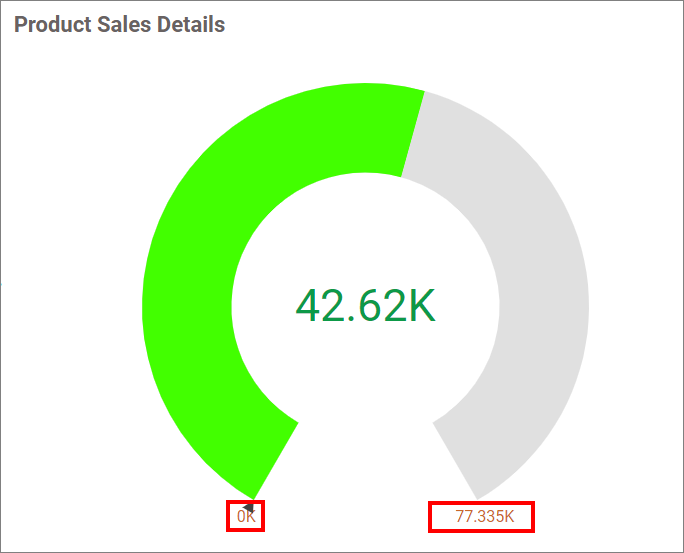
Show Difference Value
When binding both actual and target values in the gauge, this option will be shown. This allows you to hide or show the difference value of the actual and target value with its percentage value. The default value is true.
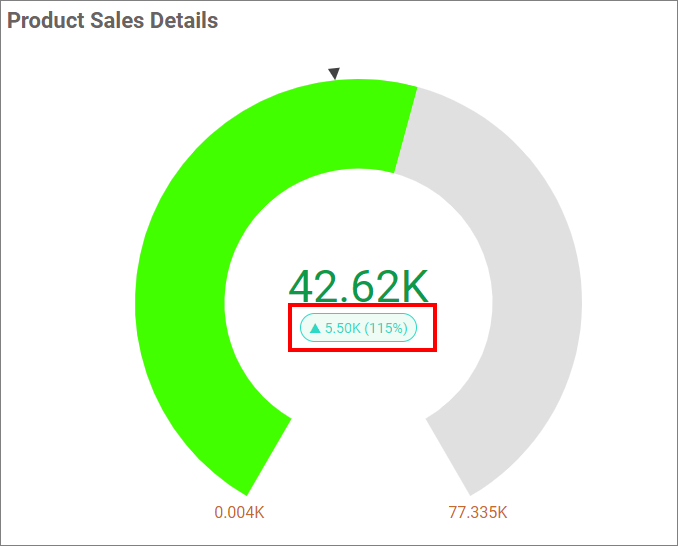
Title Color
Customize the Radial Gauge title color. The default value is #000000. This option will be disabled if the series is not configured in the Radial Gauge.
Color Settings
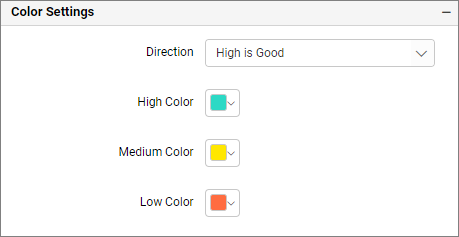
Direction
Set the value label status to High is Good or Low is Good. The default setting is High is Good. This option is enabled only when configuring the actual value and target value.
Customize the color values for the High, Medium, and low colors from the provided color pickers.
Pointer Settings
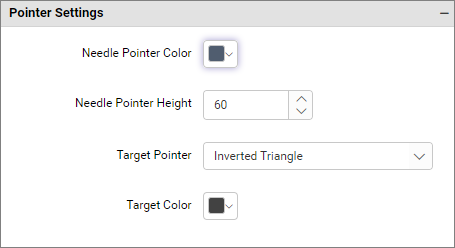
Needle Pointer Color
Change the color of the needle pointer.
Needle Pointer Height
Increase or decrease the height of the needle by changing the Needle pointer height.
Target Pointer
Change the pointer to a line, triangle and inverted triangle.
Target Color
Change the color for the target pointer.
Needle Pointer Customization
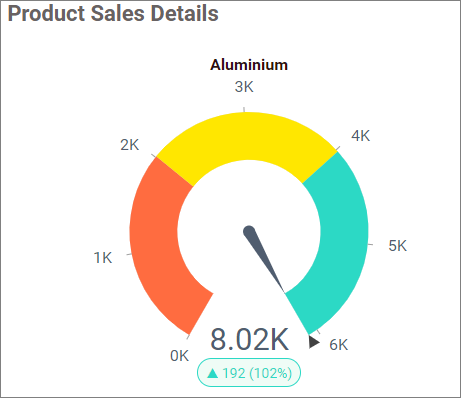
Range with Needle
Display the actual value by coloring the region and set the needle pointer up to the actual value in the Radial Gauge.
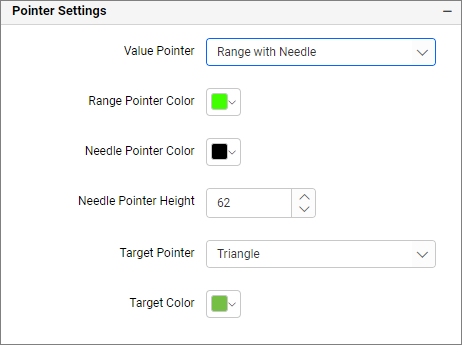
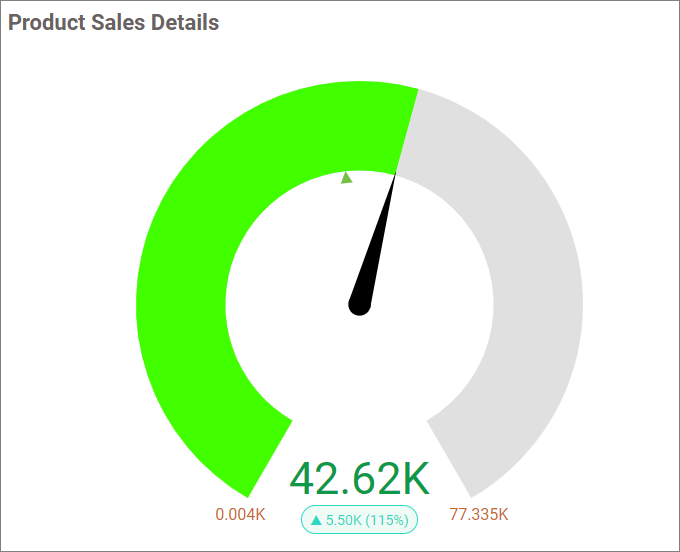
Scale Settings
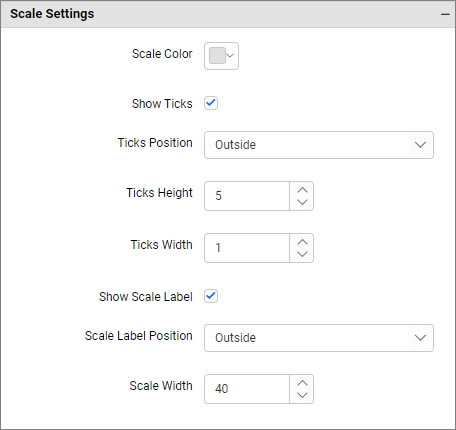
Scale Color
Set the color of the scale. The default value is #e0e0e0.
Show Ticks
Allows you displays the ticks for gauge scales. The default value is false. The interval between ticks will be auto-calculated.
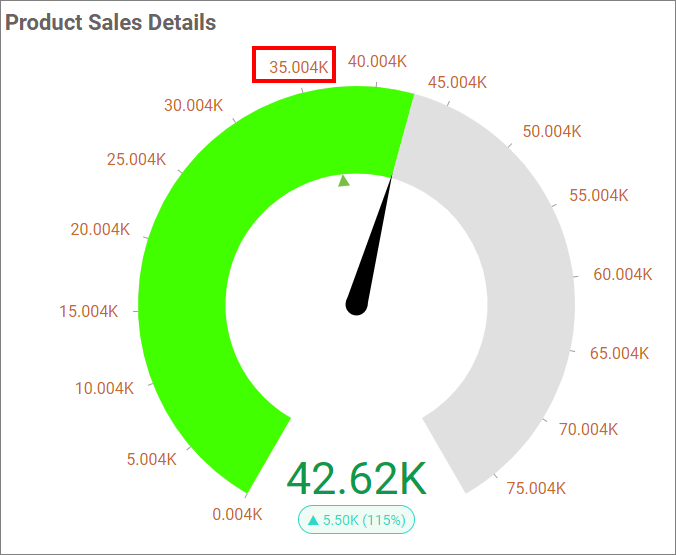
If you check the Show Ticks property, the Ticks Position, Ticks Height, and Ticks Width properties will be shown.

Ticks Position
You can change the tick’s position to either inside or outside. The default value is outside. This option is displayed only when the Show Ticks option is enabled.
Ticks Height
Allows you to change the tick’s height. The minimum and maximum values of the tick’s height are 1 and 10 respectively, with the default value being 5. This option is displayed only when the Show Ticks option is enabled.
Ticks Width
Allows you to change the tick’s width of the gauge. The minimum and maximum values of the tick’s width are 1 and 5 respectively, with the default value being 1. This option is displayed only when the Show Ticks option is enabled.
Scale Width
Allows you to change the scale width of the gauge. The minimum and maximum values of the gauge are 1 and 60 respectively, with the default value being 40.
Show Scale Label
Allows you to display the scale label of the gauge. The default value is true.
By enabling this property, the Scale Label Position property will be shown.

Scale Label Position
Allows you to change the scale label position. The default value is outside. This option will be disabled if the gauge type is half circle and the Show Ticks option is false.
Range Settings

Show Range
You can enable or disable this option to display the scale with three different ranges. The default value is false.
NOTE: If you enable Show Range, the needle pointer will be set as a fixed pointer and the range pointer option will not be displayed in the property panel.
Range
You can select a range to change its start, end, and color values.
NOTE: Currently, you can configure only three ranges.
Start
Allows you to set the start value of the selected range. This option is displayed only if Show Range is true.
End
Allows you to set the end value of the selected range. This option is displayed only if Show Range is true.
Color
Allows you to set the color of the selected range. This option is displayed only if Show Range is true.
Value Color
You can customize the color for the Actual value displayed in the Radial Gauge by range color or default label color.
Label Color
You can customize the color for the Radial Gauge labels with the range color or default color.
Link
You can enable linking and configure it to navigate to a general URL with or without parameters. For more details, refer to the linking URLs.
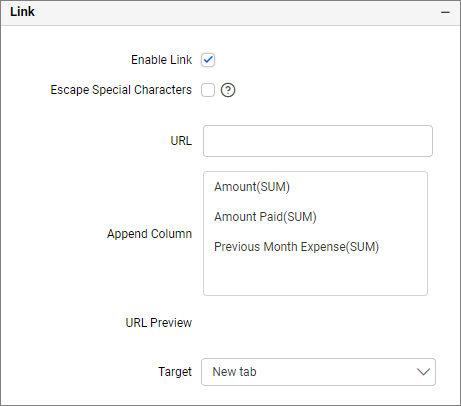
Font settings
This section allows you to customize the font size of radial gauge elements.
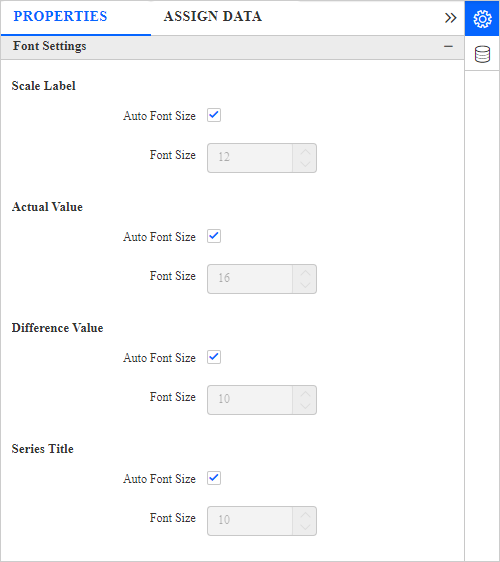
Auto font Size and font size
By default, the Auto Font Size property is enabled. The Auto font size property is used to set the font size based on the dashboard viewing client machine resolution. If the user wants to customize or set the fixed font size, then the user needs to disable auto font size and set the required font size.
Widget with Auto Font Size
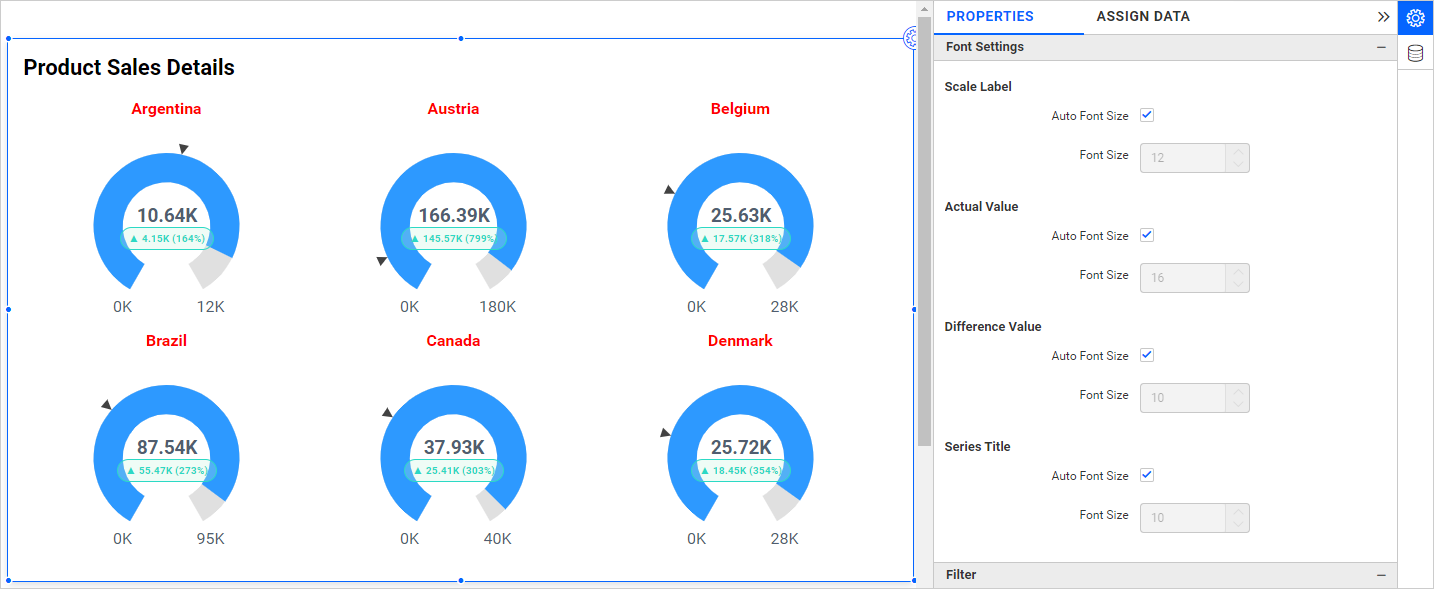
Scale Label Font Size
This option allows you to customize the font size of scale labels. While the Auto Font Size option is enabled, the font size will be applied based on resolution.
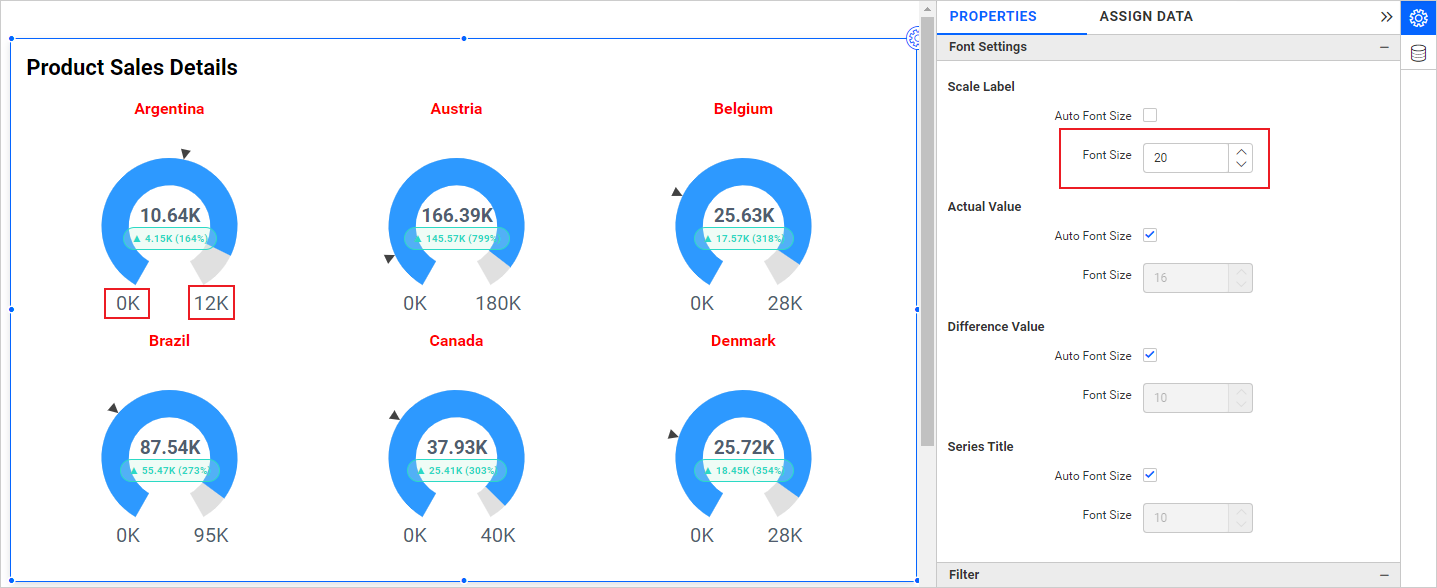
Actual Value Font Size
This option allows you to customize the font size of the Actual Value. While the Auto Font Size option is enabled, the font size will be applied based on gauge size.
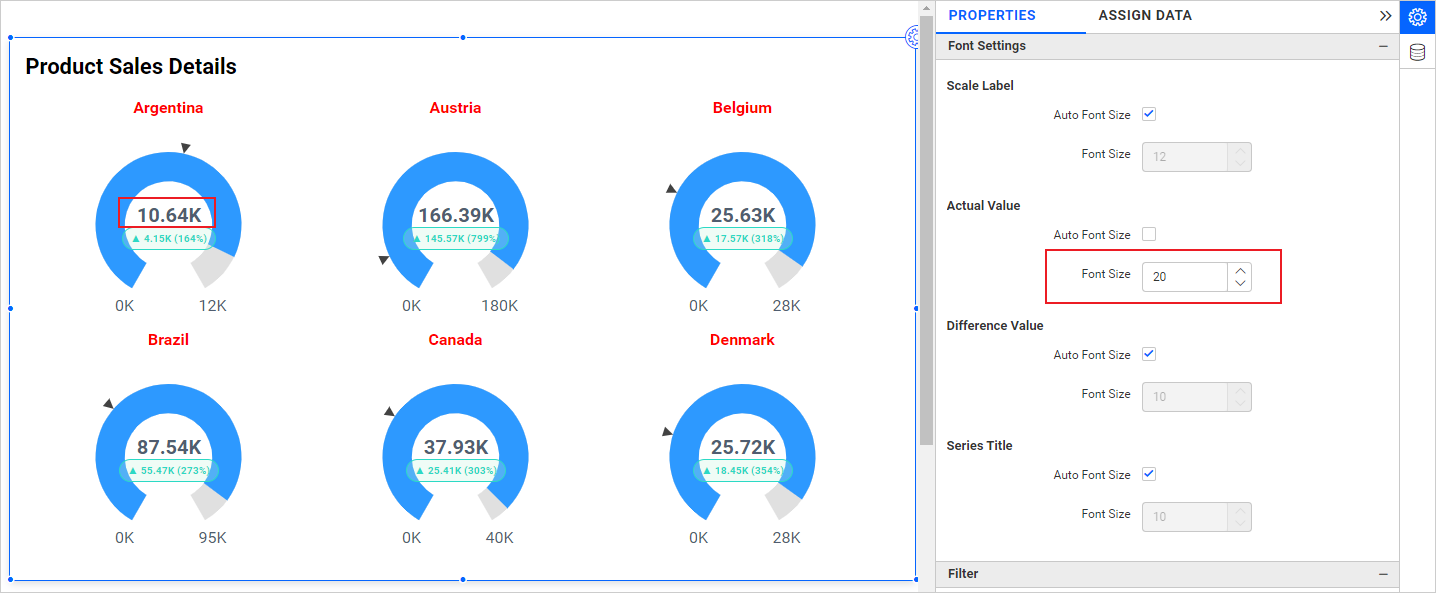
Difference Value Font Size
This option allows you to customize the font size of the Actual Value. While the Auto Font Size option is enabled, the font size will be applied based on gauge size.
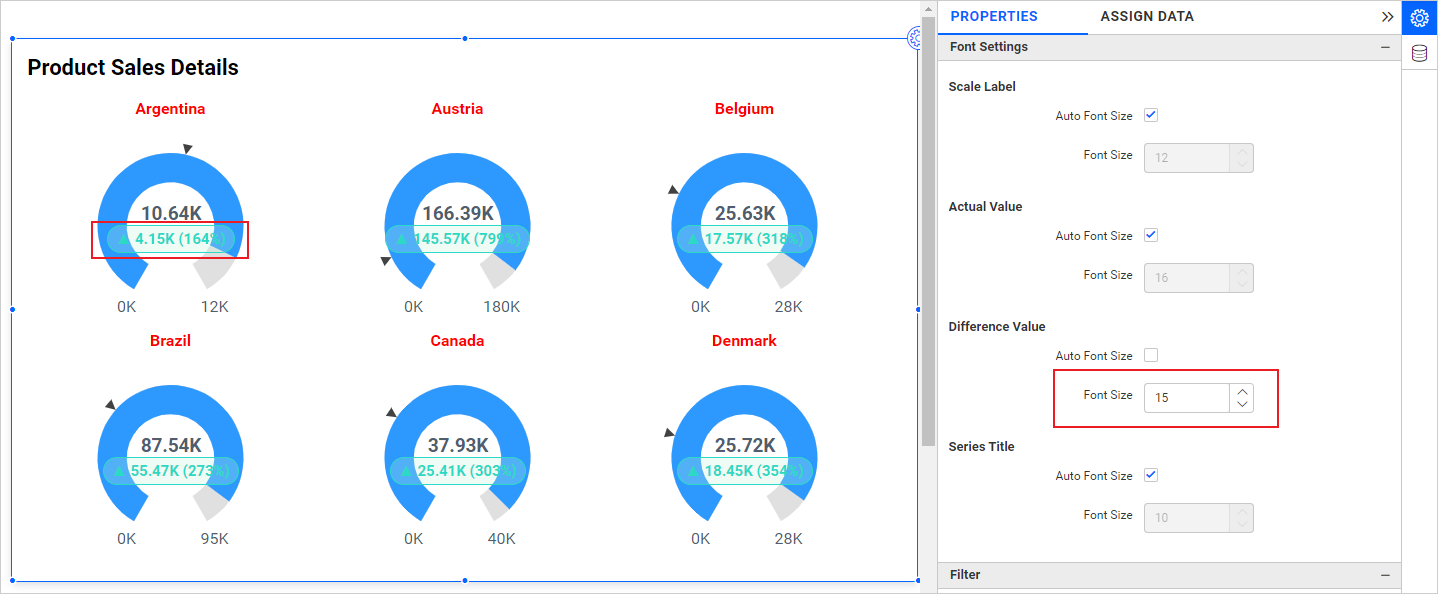
Series Title Font Size
This option allows you to customize the font size of the Series Title. While the Auto Font Size option is enabled, the font size will be applied based on resolution.
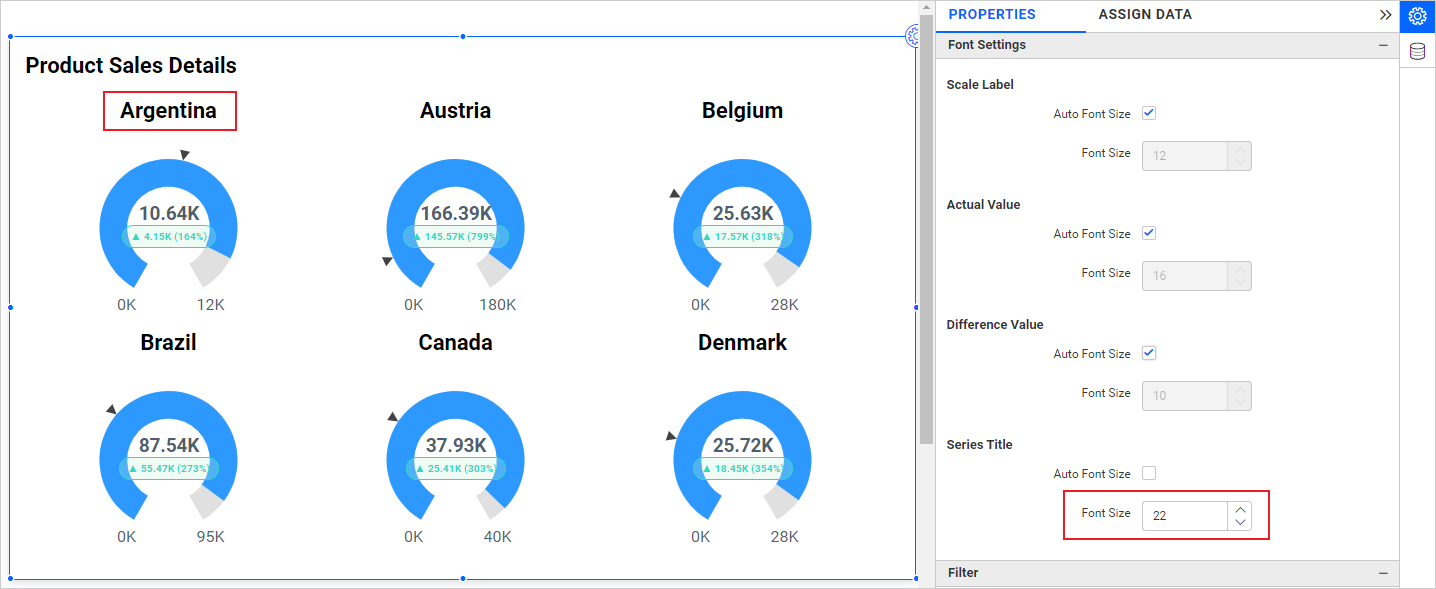
Filter

Ignore filter actions
This allows you to define the radial gauge widget to ignore responding filter actions applied to other widgets on the dashboard.
Enable Hierarchical Filter
The Radial Gauge widget can be set to act as a master widget by checking the Act as Master Widget option. The Ignore Filter Actions options enable the Radial gauge widget not to be filtered by any other master widgets during the interaction time in both preview and published modes.
NOTE: The Act as Master Widget option will be enabled only when the Series section is configured.
How to apply advanced conditional formatting
The color of various properties in the Radial gauge can be customized from the corresponding properties section, as explained in the formatting section. This will apply the same color for all records.
If you have the requirement to highlight any data based on certain conditions, you may need to enable the advanced formatting option.
How to enable advanced formatting
In the properties pane, enable the Advanced Setting option provided under the formatting section.

Now, the Conditional Formatting dialog opens.
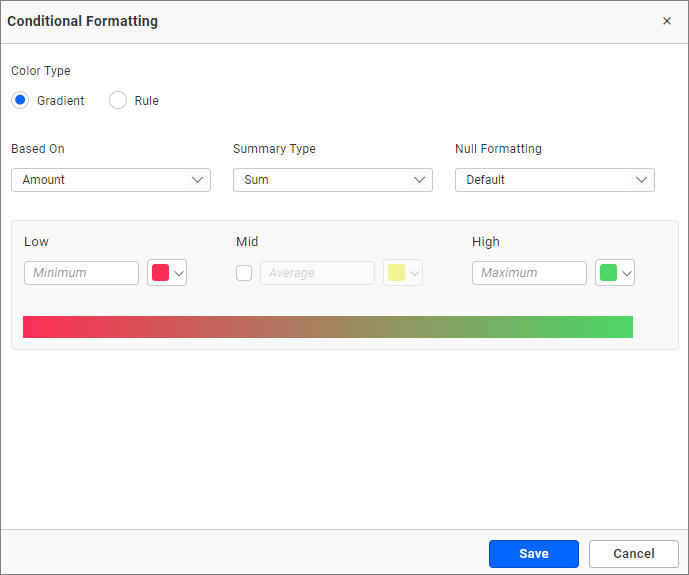
Gradient based
The Gradient color format requires the Low and High color values. The data will be compared within this range, and the matching color will be applied to the Range pointer of the Gauge widget.
If any widget data is not present within the given limit, then the property panel’s range pointer color will be applied to the gauge widget.
After applying the gradient conditions

Based On field and Summary Type
From the Conditional Formatting dialog, you can choose the based-on field and the summary type to apply the conditions.
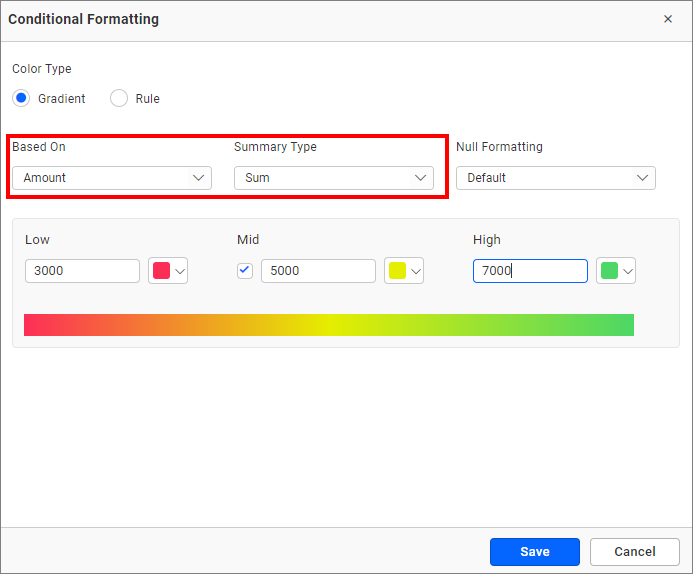
NOTE: Any field from the configured data source can be selected as the
Based-on field.
Rule based
You can add the required conditions instead of providing a simple range using the rule based conditional formatting.
The based-on field and the summary type are customizable as in the gradient-conditional type. Also, you can choose the Value type (value/percentage) from the drop-down.
NOTE: The percentage will be calculated using the maximum value of the Based-on field.
You can customize more than one property using the rule-based conditional formatting.
- Range pointer color
- Actual value color
- Needle pointer color (Applicable only when the needle pointer is used.)
- Target pointer color
- Title color (Applicable only when the series is configured.)
NOTE: If the condition is met, the colors will be applied accordingly for the corresponding properties. NOTE: If the condition is not met, the property panel color will be applied. NOTE: If more than one condition is met, the last applied condition will be used.

Measure condition
Conditional formatting condition:
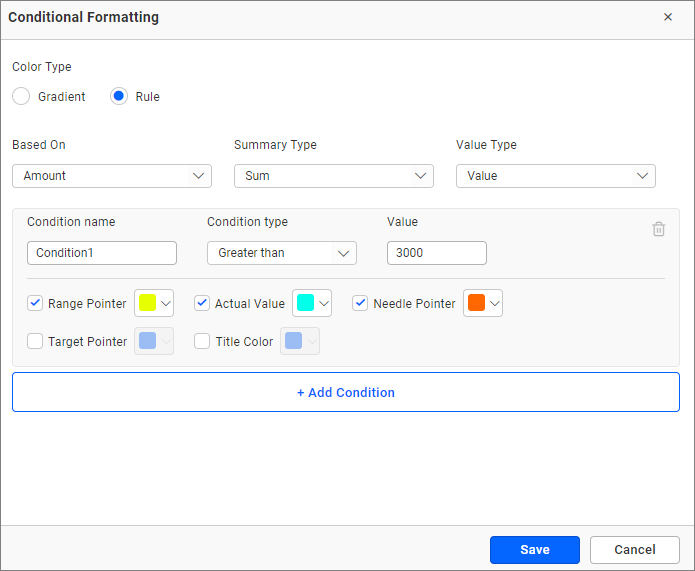
After applying the conditional formatting:
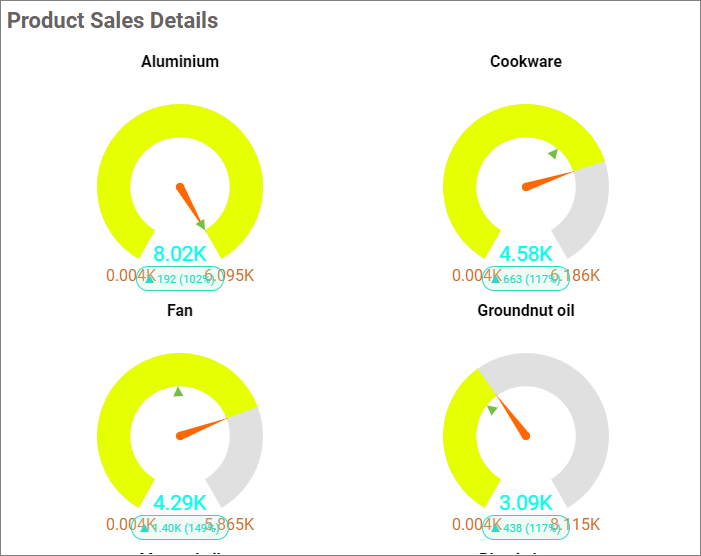
Text condition
You can also use text-based matching for the configured series field as shown in the screenshots.

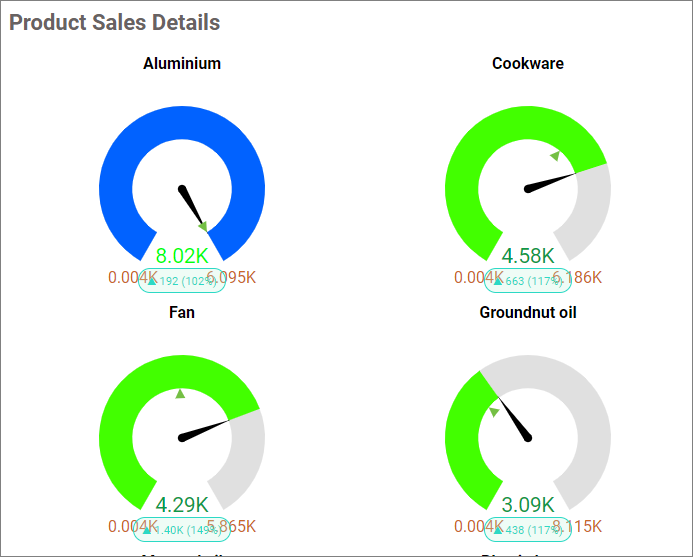
Condition Type
You can choose from the following types:
- Starts with
- Ends with
- Contains
- Not Contains
- Equals
- Not Equals
Value
The conditional value for which you need to apply formatting.
Case sensitive
Indicating whether the value is case sensitive or not.
Container Appearance
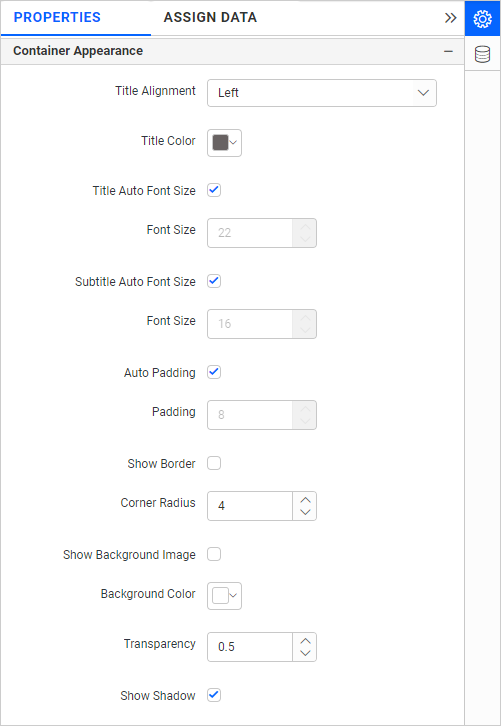
Title Alignment
This allows you to handle the alignment of the widget title to either left, center, or right.
Title Color
This allows you to apply the text color to the widget title.
Title Auto Font Size
Enabling Auto Font Size will adjust the font size of the title automatically if the screen resolution varies.
Font Size
This allows you to apply the specified font size to the widget title if Title Auto Font Size is disabled. The value can be between 10 and 44.
Subtitle Auto Font Size
Enabling Auto Font Size will adjust the font size of the subtitle automatically if the screen resolution varies.
Font Size
This allows you to apply the specified font size to the widget title if Subtitle Auto Font Size is disabled. The value can be between 10 and 32.
Auto Padding
Enabling Auto Padding will adjust the padding of the widget container automatically if the widget size varies.
Padding
This allows you to customize the padding of the widget container if Auto Padding is disabled. The value can be between 0 and 25.
Show Border
This allows you to toggle the visibility of the border surrounding the widget.
Corner Radius
This allows you to apply the specified radius to the widget corners if Show Border is enabled. The value can be between 0 and 10.
Show Background Image
This allows you to set the background color for the radial gauge widget.
Background Color
This allows you to set the background color to the radial gauge widget.
Transparency
This property allows you to specify the transparency for the background color.
Show Shadow
This allows you to toggle the visibility of the shadow surrounding the widget.
Container actions
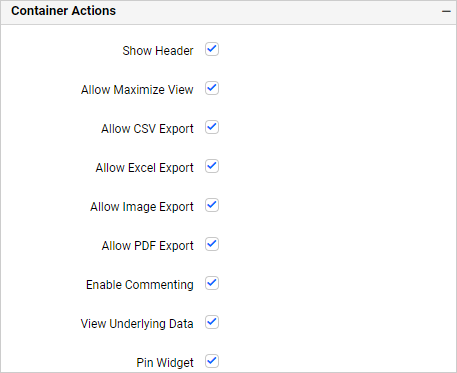
Show Header
This allows you to enable or disable the widget title of the radial gauge.
Allow Maximize View
This allows you to enable or disable the maximized mode of the radial gauge widget. The visibility of the maximize icon in the widget header will be defined based on the setting in the viewer.
Allow CSV Export
This allows you to enable or disable the CSV export option for the radial gauge widget. Enabling this allows you to export the summarized data of the widget view to CSV format in the viewer.
Allow Excel Export
This allows you to enable or disable the Excel export option for the radial gauge widget. Enabling this allows you to export the summarized data of the widget view to (.xlsx or .xls) format in the viewer.
Allow Image Export
This allows you to enable or disable the Image export option for the radial gauge widget. Enabling this allows you to export the view of the widget to image format (.jpg), (.png), or (.bmp) in the viewer.
Allow PDF Export
This allows you to enable or disable the PDF export option for the radial gauge widget. Enabling this allows you to export the view of the widget to pdf format in the viewer.
Enable Comments
This allows you to enable or disable comment for the dashboard widget. For more details, refer to the Commenting Widget.
Allow View Underlying Data
This allows you to visualize the raw data associated with a widget at runtime.
To learn more about viewing the underlying widget data, refer to the view data documentation.
Pin Widget
This allows you to pin the widget.
Responsive Behavior
We hide the widget elements based on the size of the widget for better readability.
When the gauge is placed with below 150 pixels of height and width, labels and ticks will be hidden.

- How to configure data to Radial Gauge
- Actual Value
- Aggregate Function
- Renaming fields
- Filtering data
- Formatting data
- Target Value
- Series
- Settings
- Minimum Value
- Maximum Value
- Hidden Column
- Linking
- Filtering
- View Data
- How to format the Radial Gauge
- General Settings
- Name
- Subtitle
- Description
- Basic Settings
- Show Tooltip
- Gauge Type
- Half Circular Gauge
- Full circular Gauge
- Minimum Value
- Maximum Value
- Enable Animation
- Show Actual value
- Value Color
- Label Color
- Show Difference Value
- Title Color
- Color Settings
- Direction
- Pointer Settings
- Range with Needle
- Scale Settings
- Scale Color
- Show Ticks
- Ticks Position
- Ticks Height
- Ticks Width
- Scale Width
- Show Scale Label
- Scale Label Position
- Range Settings
- Show Range
- Range
- Start
- End
- Color
- Value Color
- Label Color
- Link
- Font settings
- Auto font Size and font size
- Widget with Auto Font Size
- Scale Label Font Size
- Actual Value Font Size
- Difference Value Font Size
- Series Title Font Size
- Filter
- Ignore filter actions
- Enable Hierarchical Filter
- How to apply advanced conditional formatting
- How to enable advanced formatting
- Gradient based
- Based On field and Summary Type
- Rule based
- Measure condition
- Text condition
- Condition Type
- Value
- Case sensitive
- Container Appearance
- Title Alignment
- Title Color
- Title Auto Font Size
- Subtitle Auto Font Size
- Auto Padding
- Show Border
- Corner Radius
- Show Background Image
- Background Color
- Transparency
- Show Shadow
- Container actions
- Show Header
- Allow Maximize View
- Allow CSV Export
- Allow Excel Export
- Allow Image Export
- Allow PDF Export
- Enable Comments
- Allow View Underlying Data
- Pin Widget
- Responsive Behavior
- How to configure data to Radial Gauge
- Actual Value
- Aggregate Function
- Renaming fields
- Filtering data
- Formatting data
- Target Value
- Series
- Settings
- Minimum Value
- Maximum Value
- Hidden Column
- Linking
- Filtering
- View Data
- How to format the Radial Gauge
- General Settings
- Name
- Subtitle
- Description
- Basic Settings
- Show Tooltip
- Gauge Type
- Half Circular Gauge
- Full circular Gauge
- Minimum Value
- Maximum Value
- Enable Animation
- Show Actual value
- Value Color
- Label Color
- Show Difference Value
- Title Color
- Color Settings
- Direction
- Pointer Settings
- Range with Needle
- Scale Settings
- Scale Color
- Show Ticks
- Ticks Position
- Ticks Height
- Ticks Width
- Scale Width
- Show Scale Label
- Scale Label Position
- Range Settings
- Show Range
- Range
- Start
- End
- Color
- Value Color
- Label Color
- Link
- Font settings
- Auto font Size and font size
- Widget with Auto Font Size
- Scale Label Font Size
- Actual Value Font Size
- Difference Value Font Size
- Series Title Font Size
- Filter
- Ignore filter actions
- Enable Hierarchical Filter
- How to apply advanced conditional formatting
- How to enable advanced formatting
- Gradient based
- Based On field and Summary Type
- Rule based
- Measure condition
- Text condition
- Condition Type
- Value
- Case sensitive
- Container Appearance
- Title Alignment
- Title Color
- Title Auto Font Size
- Subtitle Auto Font Size
- Auto Padding
- Show Border
- Corner Radius
- Show Background Image
- Background Color
- Transparency
- Show Shadow
- Container actions
- Show Header
- Allow Maximize View
- Allow CSV Export
- Allow Excel Export
- Allow Image Export
- Allow PDF Export
- Enable Comments
- Allow View Underlying Data
- Pin Widget
- Responsive Behavior